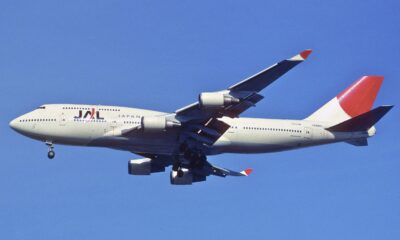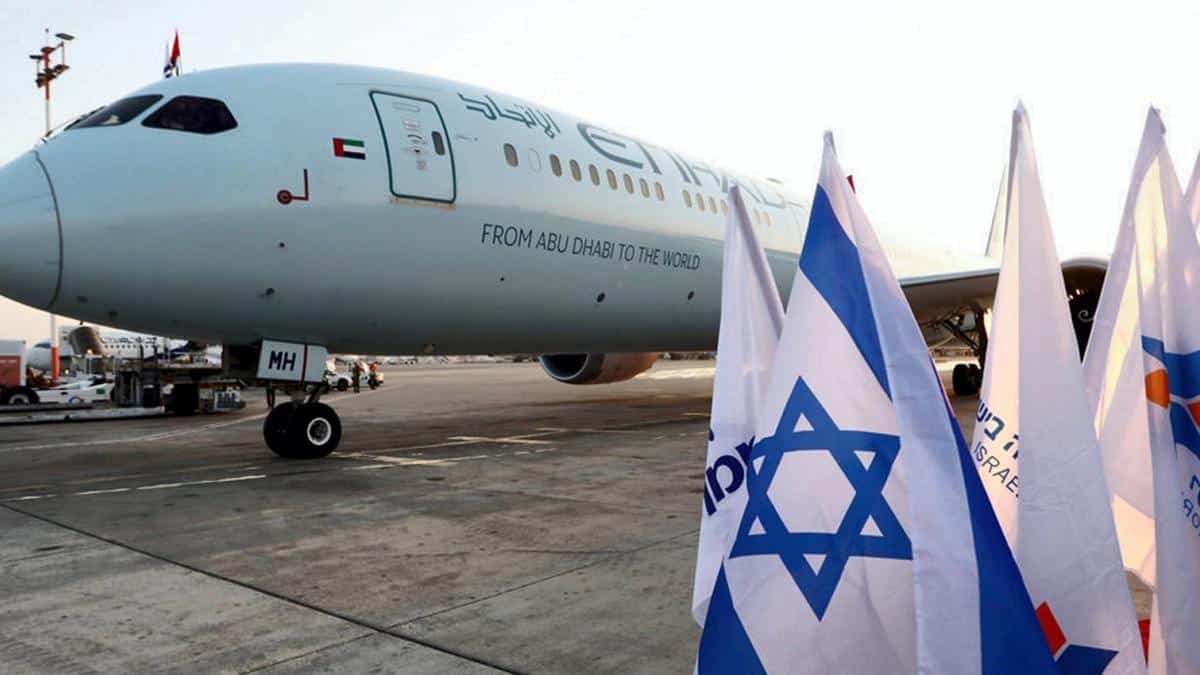Aerospace
In Gesture To Israel, Saudi Arabia Opens Airspace To ‘All Carriers’.
In a gesture of seeming generosity towards Israel ahead of the arrival of US President Joe Biden, Saudi Arabia declared on Friday that it was relaxing restrictions on “all carriers” accessing its airspace.

In a gesture of seeming generosity towards Israel ahead of the arrival of US President Joe Biden, Saudi Arabia declared on Friday that it was relaxing restrictions on “all carriers” accessing its airspace. The US president hailed Riyadh’s “historic” decision as the most recent act of accommodation toward the Jewish state, which Riyadh continued to refuse despite Israel’s intensive efforts to establish relations with Arab nations.
According to a statement posted on Twitter, the civil aviation authority “announces the decision to open the Kingdom’s airspace for all air carriers that meet the authority’s conditions for overflying.” Prior to Biden’s arrival in Israel on Wednesday, Washington had made suggestions that additional Arab countries might take action to advance relations with Israel, causing rumors about whether Riyadh would budge from its steadfast stance of delaying the establishment of formal bilateral ties until the conflict with the Palestinians is resolved. The United Arab Emirates, Bahrain, and Morocco all established diplomatic connections with Israel in 2020 as part of the US-mediated Abraham Accords, and the monarchy made no protests at the time.
Yet analysts have stressed that any immediate gains are likely to be incremental and that Riyadh will probably not agree to formal ties — not during Biden’s visit or while King Salman, 86, still reigns. Biden will travel to the Saudi city of Jeddah on the Red Sea coast Friday afternoon, despite a previous vow to treat the kingdom as a “pariah” over the 2018 murder and dismemberment of Saudi journalist Jamal Khashoggi.
Can the tracking of in-flight catering improve airline sustainability.(Opens in a new browser tab)
Shortly after the Abraham Accords were announced in 2020, Saudi Arabia declared that UAE planes to “all countries” could overfly the country and permitted an Israeli plane to fly over while travelling to Abu Dhabi.
Following Friday’s announcement, aeroplanes flying to and from Israel are no longer subject to overflight restrictions.
Israel has pushed for the right to use overflights to reduce connections to Asian destinations. Additionally, authorities seek to allow direct travel to Saudi Arabia for Muslim pilgrims from Israel. Currently, they must spend money on stopovers in foreign nations. Crown Prince Mohammed bin Salman, the de facto ruler of Saudi Arabia, has brought about “a profound change in Saudi thought” regarding Israel, according to Dan Shapiro, a former ambassador to Washington who Biden is scheduled to meet with on Friday.

Aerospace
Which is bigger 777x or 787 aircraft ?

The 777X is a new series of the Boeing 777 family and is designed to be larger and more efficient than its predecessor. It features two variants: the 777-8 and the 777-9, being the larger of the two.
The Boeing 777X emerges as the larger sibling within the Boeing family, representing a significant leap forward in both size and efficiency. Comprising two variants, the 777-8 and the 777-9, the latter takes the crown as the larger of the two. With its expansive fuselage and impressive wingspan, the 777X is tailored for long-range journeys and boasts a substantial passenger capacity.
On the other hand, the Boeing 787, affectionately known as the Dreamliner, occupies a niche in the market as a smaller yet formidable aircraft designed for medium to long-range flights. Its distinguishing feature lies in its composite fuselage, a technological marvel that renders it lighter and more fuel-efficient compared to conventional aluminum counterparts. The Boeing 777X is larger than the Boeing 787 aircraft.
When it comes to passenger capacity, the 777-9 reigns supreme, typically accommodating a sizeable contingent of 400-425 passengers in its standard configuration. In contrast, the 787, with its more modest dimensions, typically carries between 240-290 passengers, depending on the variant and layout.
One of the remarkable innovations introduced with the 777X is its folding wingtips, a feature designed to address the logistical challenges of accommodating such a large aircraft in conventional airport gates. These folding wingtips enable the 777X to retract its wings, allowing it to fit into gates designed for smaller aircraft while still reaping the benefits of an extended wingspan during flight, thereby enhancing fuel efficiency and operational flexibility
Aerospace
China Secures Production Certificate for Mass Production of Pilotless eVTOL Aircraft

The first passenger-carrying pilotless electric vertical takeoff and landing (eVTOL) aircraft in the world, the EH216-S, has received the Production Certificate for its eVTOL aircraft from the Civil Aviation Administration of China (CAAC).
This is a significant milestone for EHang Holdings Limited, the leading UAM technology platform company in the world. This outstanding accomplishment is another big step towards mass manufacturing for the eVTOL aircraft and the ensuing commercial operations, building on the ground-breaking acquisition of the Type Certificate and the Standard Airworthiness Certificate for the EH216-S.
The PC is a crucial certificate that the aircraft maker receives from the CAAC, the country’s aviation authority. By obtaining this certificate, EHang has demonstrated that it has set up a quality management system for mass production that satisfies the airworthiness regulation standards set forth by the CAAC, and the company has been given permission to continue producing mass quantities.
It is also a strong guarantee of the calibre of the goods made by EHang. Raw materials, supplier management, manufacturing organisation, production quality control, aircraft pre-delivery test, after-sales repair and maintenance, etc. are all included in the mass production quality management system for the EH216-S.
To ensure that every aircraft and its components that roll off the production line strictly adhere to the approved type design and safety requirements, the system sets clear guidelines and documentation for every step in the production procedure. This ensures comprehensive traceability and safety control.
Aerospace
Four Airbus A380 Superjumbos lined up to be scrapped

In a strategic move aimed at reclaiming valuable resources from the iconic Airbus A380 aircraft, VAS Aero Services and Dr. Peters Group have announced a significant collaboration.
This partnership marks a milestone in aviation logistics and aftermarket services, with four of these colossal planes slated for teardown and redistribution of used serviceable material (USM).
The venture between VAS Aero Services, renowned for its expertise in aircraft dismantlement, and Dr. Peters Group, a prominent Germany-based investment fund management firm, underscores a commitment to sustainable aviation practices. This isn’t their first foray into scrapping A380s; their successful partnership has already seen the dismantlement of these aircraft, making them pioneers in this niche.
Under the agreement, the latest consignment brings the tally to eight A380s entrusted to VAS by Dr. Peters Group. Managing Director Christian Mailly of Dr. Peters Group emphasized the trust placed in VAS, citing their unparalleled capabilities in dismantlement and aftermarket sales network. It’s a strategic move in response to the growing demand for quality USM parts, particularly with the resurgence in reliance on the A380.
Notably, the teardown process will be carried out at various locations, optimizing the positioning of harvested parts to cater to different markets. While some parts will be positioned in Europe to support operators in the region and the Middle East, others will remain in the Asia-Pacific region. This meticulous strategy ensures efficient access to spare parts, benefiting MROs and airlines across these markets.
The decision to retire these A380s comes at a time when operators are reassessing fleet strategies amidst evolving market dynamics. Despite initial plans for quick retirement due to the emergence of more fuel-efficient alternatives, factors such as a rebound in long-haul demand and delays in new widebody deliveries have prompted operators to reconsider. The A380, with its unique capacity and capabilities, presents a practical solution for short-term capacity management.


























